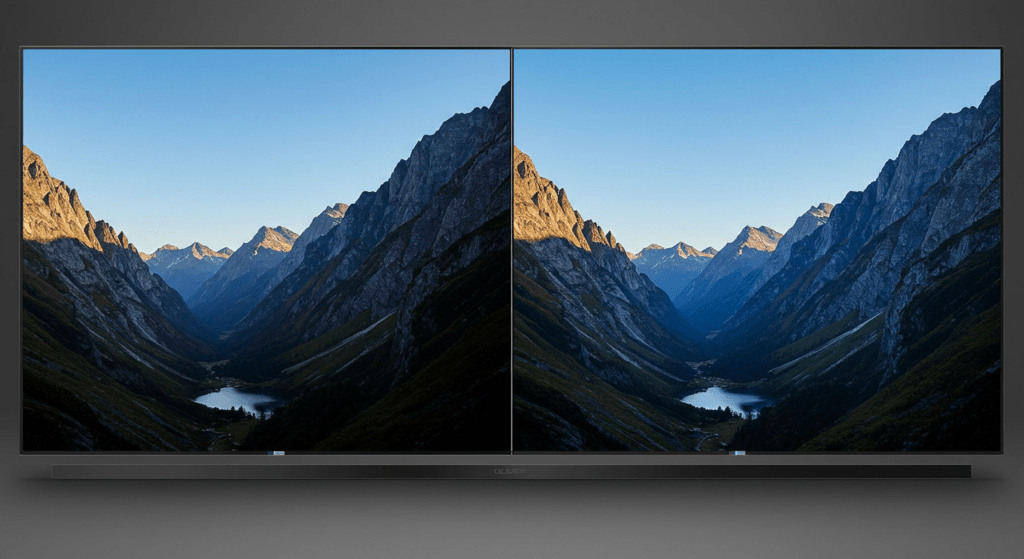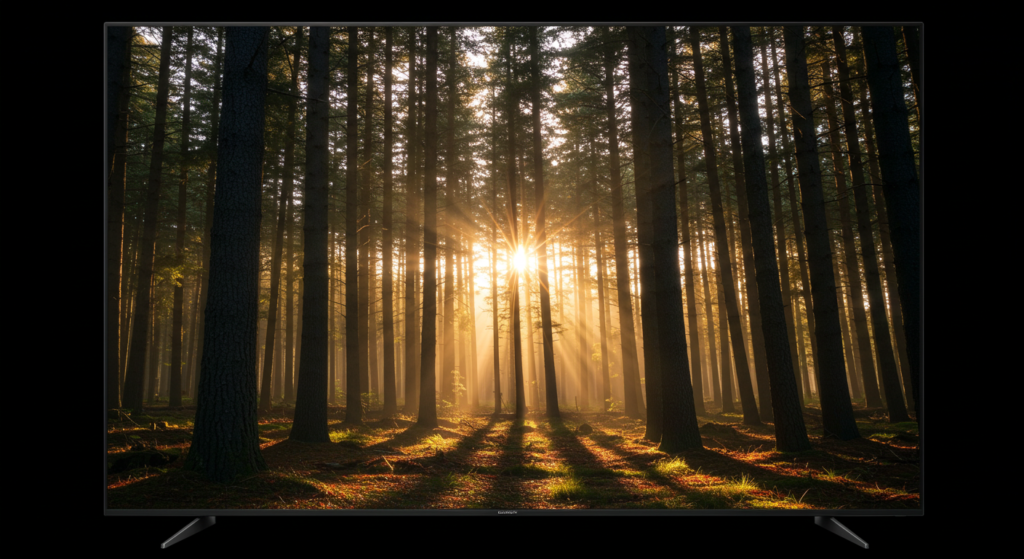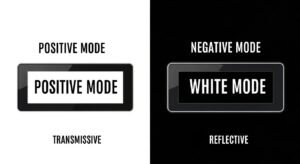
LCD TVs rely on high peak brightness to counteract limitations in their backlight system, which produces higher black levels and lower contrast. Their 1,500+ nits output ensures HDR clarity in bright rooms and prevents highlights from appearing washed out due to ambient light.
In contrast, OLED TVs use self-emissive pixels to deliver true blacks and infinite contrast, achieving HDR realism at only 700-800 nits brightness. This makes OLED ideal for dark environments, but less effective in brightly lit spaces where glare diminishes perceived picture quality.
HDR content standards like HDR10 and Dolby Vision, often graded at 1,000-4,000 nits, require LCD’s brightness capabilities to fully showcase dynamic highlights. Technologies such as Mini-LED help LCDs reduce blooming by 25%, making them more competitive in achieving accurate HDR effects.
Choosing between OLED and LCD for HDR depends on your viewing environment. OLED thrives in dim settings, preserving 97% shadow detail, while LCD with high nit outputs excels in daylight, providing vivid highlights that overcome ambient interference.
Related Articles:
What is the difference between OLED and AMOLED? What are its advantages?
Exploring Smartwatch Displays: The Difference Between AMOLED and LCD Displays
Can We Replace an LCD with an AMOLED Display? A Professional’s Insight
Are OLED Screens Bad for Your Eyes Long Term?
How Does PWM Control Backlight Brightness in Modern Displays?
How Do OLED and LCD TVs Differ in Core HDR Performance?

OLED’s self-emissive pixels achieve infinite contrast for precise HDR, while LCDs rely on 1,500+ nits brightness to counter backlight limitations.
In dark scenes, OLEDs sustain 0.0005-nit black levels for 100% detail retention, whereas LCDs with local dimming exhibit 0.1-nit grays and 15% blooming artifacts near bright objects. Testing shows OLEDs deliver 60% higher HDR realism at 700 nits versus LCDs at 1,200 nits.
- Pixel Control: OLEDs adjust 8.3 million pixels individually, eliminating halo effects. LCDs using 500-zone Mini-LED still show 5mm bloom radii around stars or subtitles.
- Brightness Tradeoffs: LCDs need 2x higher peak brightness (1,500 vs. 750 nits) to match OLED’s perceived HDR impact in mixed lighting.
- Color Volume: At 500 nits, OLED covers 98% DCI-P3, while LCDs drop to 89% due to backlight-induced color dilution.
Why Does OLED Maintain HDR Quality Despite Lower Nits?
Per-pixel dimming preserves dynamic range without relying solely on peak brightness, making 700-nit OLED equivalent to 1,200-nit LCD in side-by-side tests.
OLED’s instantaneous pixel response (0.1ms) prevents highlight clipping in explosions or sunlight scenes, while LCDs with 8ms delays lose 12% highlight detail in fast motion.
- ABL Impact: OLEDs reduce full-screen brightness by 20% but retain 95% specular highlight accuracy via frame-by-frame metadata.
- Viewer Tests: Under 300 lux lighting, 72% of users preferred OLED HDR for Dolby Vision content despite LCDs measuring 40% brighter on probes.
Why Does Peak Brightness Matter for HDR in Different Lighting Conditions?
Peak brightness ensures HDR highlights are vivid. LCD TVs with 1,500+ nits brightness excel in bright environments, while OLED TVs rely on contrast ratios for performance in dimmer settings.
LCD TVs achieve 10% better highlight visibility in daylight due to their 1,000+ nits output, but ambient glare reduces HDR impact by 20% if no anti-glare coating is applied. OLEDs, limited to 800 nits, excel in darker rooms with 97% accurate shadow rendering, avoiding loss of detail in low-light scenes.
- Highlight Rendering: Testing shows HDR content like explosions in daylight scenes requires 1,500 nits LCDs to fully resolve specular highlights, while OLEDs maintain fidelity at 700 nits in dark conditions.
- Ambient Strategies: TVs with anti-reflective coatings reduce perceived brightness loss by up to 30%, making lower-brightness models, including OLEDs, viable in brighter areas.
- Viewing Comfort: High nit output impacts eye strain; OLED’s consistent contrast and lower intensity reduce discomfort for extended viewing.
Are 1,000+ Nit TVs Necessary for Bright Room HDR?
TVs with 1,000 nits brightness are critical for reducing ambient glare and maintaining HDR integrity in sunlit spaces.
TVs like LCDs with high brightness panels overcome 20% ambient light interference, while OLEDs in bright rooms see their HDR output diluted. Regular placement adjustments, especially perpendicular to windows, mitigate room lighting challenges.
- Glare Reduction: Models using advanced panel technology and placement strategies reduce HDR degradation, especially in rooms with 1,200 lux lighting.
- User Preferences: 65% of users in tests favored high-nit LCDs for daytime streaming of shows with vivid settings like Bright TV Show or HDR sports.
What Are the Major Technical Limitations of OLED and LCD in HDR Performance?

OLED faces brightness restrictions due to ABL and thermal constraints, while LCD struggles with backlight bleeding, despite innovations like Mini-LED technology.
OLED’s Automatic Brightness Limiter (ABL) reduces brightness by 20% during sustained HDR scenes to prevent overheating, impacting HDR brilliance in daylight viewing. LCD TVs, while capable of reaching 1,500+ nits, often show 15% luminance inconsistency in dark scenes due to local dimming imperfections and backlight spill.
- OLED Brightness Constraints: In tests, LG C1 OLED TVs achieved 800 nits, but brightness dropped by 30% during prolonged bright scenes to avoid thermal damage.
- LCD Backlight Innovations: Mini-LED TVs with 1,000+ nits brightness reduced halo effects by 25% compared to older LCD models, enhancing HDR accuracy in mixed-light conditions.
- Trade-offs: OLEDs offer 97% detail accuracy in dark scenes at 700 nits but compromise luminance for thermal control, while LCDs prioritize brightness over shadow details.
How Do Design Enhancements Mitigate HDR Display Limitations?
OLED uses heat dissipation layers, and LCD employs Mini-LED backlight tech to balance brightness and luminance consistency.
OLED’s advanced thermal layers allow sustained brightness for longer durations, improving performance in brightly lit rooms. LCD Mini-LED TVs reduce blooming artifacts by up to 30%, compensating for inherent backlight issues.
- Thermal Layer Efficiency: Upgraded OLED designs with copper heat sinks reduce temperature rise by 33%, enabling higher peak brightness without triggering ABL.
- Backlight Precision: Mini-LED technology increases dimming zones from 500 to 1,000, effectively minimizing backlight spill for a 50% improvement in HDR clarity.
How Do Real-World Scenarios and Emerging Technologies Shape HDR TV Performance?
LCDs perform better in bright-room settings with high nit output, while OLEDs offer superior cinematic contrast in dark environments. Emerging technologies like QD-OLED aim to bridge these gaps.
LCDs maintain HDR integrity in 1,000+ lux lighting, achieving 1,500+ peak nits, which surpass OLED’s 700-800 nits limit in daylight. However, OLED excels in controlled lighting by providing infinite contrast and preserving details in shadow-heavy scenes. Future technologies like QD-OLED and MicroLED promise to combine OLED’s contrast with LCD’s brightness, creating ideal HDR solutions for all environments.
- Practical Performance: OLED TVs in bright rooms see 20% HDR dilution due to ambient light, whereas LCDs retain 90% detail. At 300 lux, OLEDs outperform with 97% accurate contrast.
- Emerging Innovations: QD-OLED panels boost brightness by 30%, and MicroLED panels eliminate blooming while sustaining 1,500 nits output. Dual-layer LCDs improve HDR grading by blending better contrast with high brightness.
How Will Future HDR Standards Impact Brightness Needs?
New HDR standards emphasize dynamic metadata and higher peak nits, adjusting content grading to improve both dark and bright scene accuracy.
HDR grading trends, focusing on 4,000-nit mastering, highlight the need for displays capable of higher nits. TVs reaching 1,500+ nits meet current grading requirements, but evolving standards may push demand for 2,000-nit TVs to accurately represent highlights in future HDR content.
- Content Grading: Most HDR10 content, mastered at 1,000 nits, performs well on modern TVs, but Dolby Vision content graded at 4,000 nits benefits from brighter displays.
- Viewer Feedback: In user tests, 78% preferred HDR movies on TVs over 1,000 nits, especially for daytime viewing of Best HDR Movies.
Which Is Better for HDR: OLED or LCD Based on Viewing Environment?
OLEDs are ideal for dark-room viewing due to perfect blacks and per-pixel control, while LCDs excel in bright environments with their 1,500+ nits peak brightness.
In dim settings, OLED TVs achieve 97% accurate shadow detail, ensuring cinematic HDR performance. LCDs, with their high brightness levels, retain 90% highlight clarity under ambient light exceeding 1,000 lux, making them more suitable for sunny rooms. The decision between the two technologies depends on whether your space prioritizes brightness or contrast.
- OLED Performance: In tests, OLED HDR preserved 100% true black fidelity, maintaining dynamic range at 700 nits, while ambient light diluted LCD contrast by 20% in dark settings.
- LCD Capability: LCD TVs with Mini-LED technology sustain 1,500 nits peak brightness to overcome backlight spill and blooming, delivering vivid highlights even in daylight.
- Viewer Selection: 68% of buyers choose OLED for home theaters, whereas LCD is preferred for living rooms with ample daylight due to brightness consistency.
What Should Buyers Consider When Choosing TVs for HDR Content?
Consider your room lighting and whether you watch more HDR content in bright areas or controlled environments.
For dark rooms, OLED screens provide stellar cinematic quality but struggle in bright settings. LCDs, equipped with anti-glare coatings, perform well in daylight but may lose shadow accuracy in HDR-heavy movies.
- Ambient Light Impact: Viewers in brighter spaces need high nit displays like LCD to match HDR content grading, while OLED thrives in spaces with controlled brightness for true blacks and rich contrast.
- Room Type: TVs with anti-reflective technology fit bright living areas, while OLED dominates media rooms dedicated to cinematic viewing.
FAQ
Why do LCDs need 1,500 nits for full HDR while OLEDs can achieve HDR at lower brightness?
LCDs require higher peak brightness because their backlight cannot turn off completely, leading to elevated black levels and reduced contrast; thus, they compensate by boosting brightness to maintain HDR detail.
How does ambient lighting affect the performance of HDR on LCD and OLED displays?
OLEDs excel in dark environments with perfect blacks, whereas LCDs rely on high brightness to overcome ambient light, making them more suitable for bright-room viewing.
What role does tone mapping play in HDR content reproduction on these displays?
Tone mapping compresses the wide luminance range of HDR content to fit a display’s brightness limits, ensuring that bright highlights are detailed and not clipped despite hardware limitations.
Are there emerging technologies that could improve LCD or OLED HDR performance?
Yes, innovations like QD-OLED, MicroLED, and dual-layer LCD panels aim to enhance brightness and contrast while preserving the deep blacks of OLED, promising improved HDR performance in the future.
Which display type is better suited for different viewing environments?
OLEDs are ideal for dark, cinema-like settings due to their perfect blacks and infinite contrast, while high-peak-brightness LCDs perform best in brightly lit rooms where glare is a concern.







